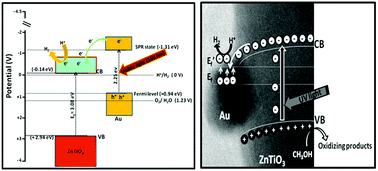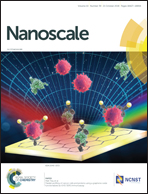Erratic charge transfer dynamics of Au/ZnTiO3 nanocomposites under UV and visible light irradiation and their related photocatalytic activities†
Abstract
The present article presents an in-depth discussion on the state-of-the-art multifarious roles of Au nanoparticles and their associated charge anti-recombination process in burgeoning photocatalysis research. Hexagonal-phase ZnTiO3 was fabricated through a sol–gel auto-combustion method by optimizing the calcination temperatures. To further improve the charge separation efficiency and visible light induced photocatalytic activity of pristine ZnTiO3, we designed a new type of Au/ZnTiO3 nanocomposite by a precipitation–deposition method. The photocatalytic activities of the Au/ZnTiO3 nanocomposites were substantiated by evaluating the rate of hydrogen evolution under both UV and visible light illumination. The photocatalytic activity of the Au/ZnTiO3 nanocomposites rises proportionally with an increase in Au content up to 1.5 wt% under UV light illumination and it produce around 285 μmol h−1 of H2 which is approximately 2.6 times higher than that produced by pristine ZnTiO3. Therefore, the Au nanoparticles present on the surface of ZnTiO3 act as electron acceptors, leading to an increase in the rate of generation and separation of charge carriers. This process helps to enhance the congregation of electrons on Au nanoparticles through the Schottky junction. The obtained results are very consistent with steady-state PL and UV light induced photocurrent measurements. Conversely, such a trend was not detected under visible light illumination. The visible light induced photocatalytic activity of Au/ZnTiO3 nanocomposites increases with a rise in Au content up to 1 wt% and thereafter decreases with further Au loading. Therefore, the initial increment in photocatalytic activity is due to the generation, separation and participation of a large number of SPR-induced charge carriers and thereafter decreases due to the recombination of SPR-generated charge carriers because of the formation of defect sites at the Au and ZnTiO3 interface. That the excess Au loading causes the recombination of SPR charge carriers was well explained by undertaking SPR-induced TRPL analysis and this result is directly followed up with the results of visible light induced photocurrent and EIS measurements. The Au/ZnTiO3 nanocomposites with optimal Au loading (1 wt%) delivered an amazingly high rate of hydrogen evolution i.e. 108 μmol h−1 with an energy conversion efficiency of 7.14%, whereas pristine ZnTiO3 shows negligible activity under visible light illumination.



 Please wait while we load your content...
Please wait while we load your content...